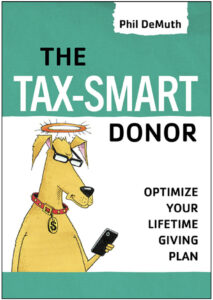Our Latest Book
“All or a portion of philanthropic contributions can generate significant tax deductions for the donor. That benefit, however, is far from automatic.” – Warren Buffett

Download our Tax Year 2025 worksheet
Download our Tax Year 2026 worksheet
“The Tax-Smart Donor presents a revolutionary approach to charitable giving by viewing it through the lens of life-cycle financial planning. Instead of treating donations as isolated events, investment advisor Phil DeMuth shows how to create an integrated strategy that optimizes your giving across your lifetime.
Through clear examples and practical scenarios, you’ll learn when and how to use powerful tax-saving techniques like donor-advised funds, qualified charitable distributions from IRAs, and gifts of appreciated securities. The book guides you through the complexities of charitable vehicles – from simple cash gifts to sophisticated charitable trusts – helping you choose the right approaches for your situation.
DeMuth introduces the concept of Giving Power to evaluate different donation strategies, while demonstrating how proper timing and tax planning can dramatically increase your philanthropic impact. Whether you’re a young professional just starting to give or a wealthy donor planning your charitable legacy, this comprehensive guide provides the roadmap for making your charitable dollars work harder and go further.”
— Claude AI 3.5 Sonnet
Phil writes about Giving Power for the Journal of Financial Planning: HERE.
Book Review from CFA Institute’s Enterprising Investor: HERE.
Phil on the Bogleheads Podcast Link HERE.
Host Rick Ferri invited me on to discuss The Tax-Smart Investor. Ferri typically knows much more about a subject than his guests do, and this was no exception. There was also a follow-up thread on the Bogleheads forum; link HERE.
One Big Beautiful Bill Charity Update
Several new items are relevant. They don’t take effect until 2026, but they have implications for giving in 2025.
- The return of modest tax-deductible charitable deductions for people taking the standard deduction.
These work just like the temporary $300 deductions we could take during COVID, except they are larger: $1,000 single/$2,000 married filing jointly. Must go to a registered 501(c)(3) charity, not a donor-advised fund or a private non-operating foundation. These deductions provide a Giving Power equal to the taxpayer’s marginal tax rate and will likely be the best deal most taxpayers will encounter until middle age, unless they secure a corporate match. During pre-retirement years, gifts of appreciated stock might be more tax-effective and allow for larger gifts, especially with the prospect of a $40,000 itemized deduction for State and Local Taxes to help clear the hurdle of the standard deduction. These new $1,000/$2,000 deductions do not add to charitable gifts on Schedule A. The new deduction starts in 2026.
- A 0.5% AGI floor on the Charitable Deduction.
This means that your charitable itemized deduction must first exceed the standard deduction and then be greater than 0.5% of your Adjusted Gross Income (line 11 on Form 1040). On $500,000 of AGI, that’s $2,500 excluded. In other words, small charitable gifts will not be deductible. Bunching gifts into big contribution years and then spreading them out to end charities via the use of donor-advised funds becomes the preferred strategy. Corporate deductions will face an even higher 1% exclusion.
This has implications for 2025, as it is the last year you can itemize your donation without incurring the first 0.5% loss.
- A 35% deduction ceiling for itemizing taxpayers in the 37% bracket.
In 2026, single filers will enter the 37% bracket with taxable income over $626,350; those married filing jointly do so with income over $751,600. They will be taxed at a 37% marginal rate, but their itemized deductions (including charitable deductions) will be capped at 35%. This represents a 5.4% loss on charitable gifts above the 0.5% floor, making 2025 the final year for larger gifting that will not be subject to this reduction. They will continue to be subject to the usual percentage-of-income limitations, however.